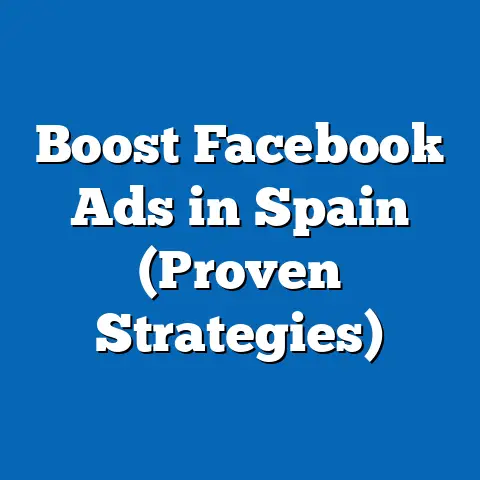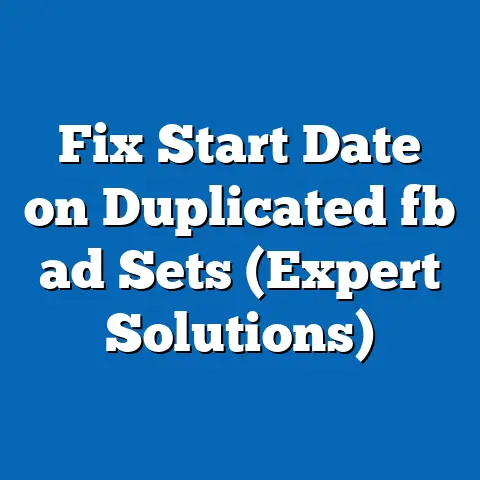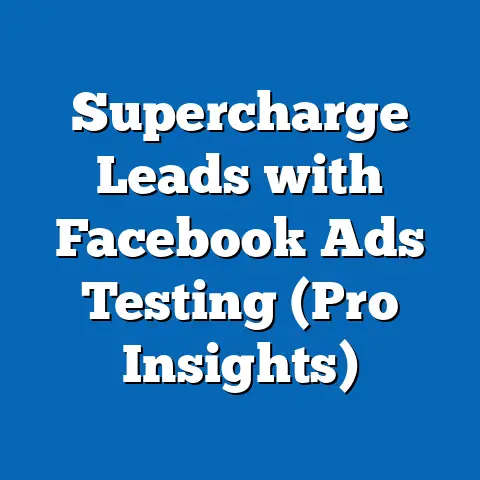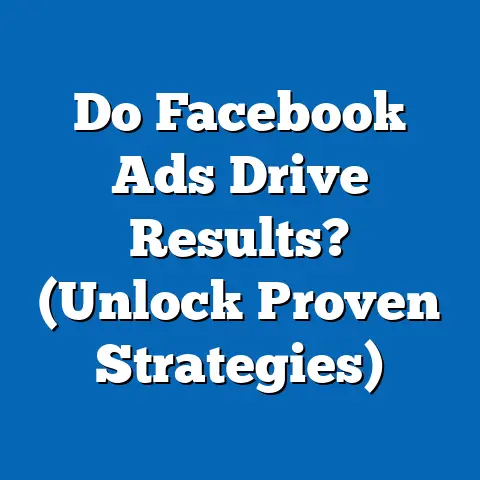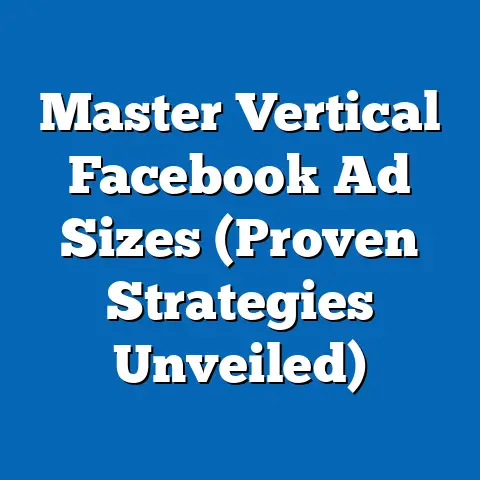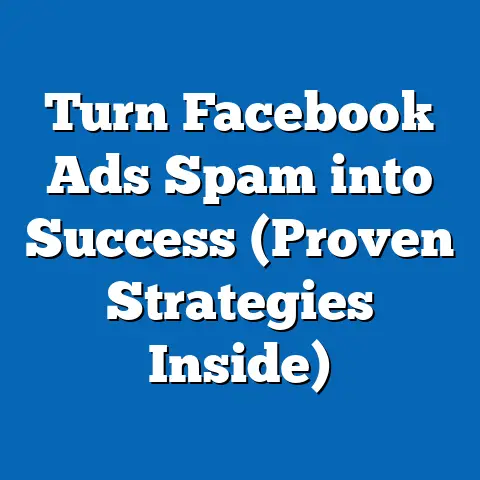Master Advanced Facebook Ads Strategies (Expert Insights)
I always find it a bit funny – in a world where attention spans are shorter than a TikTok dance craze, many businesses still think a simple image and a catchy caption are all they need to conquer Facebook. It’s like showing up to a Formula 1 race with a go-kart! The truth is, Facebook advertising has evolved into a sophisticated beast, demanding more than just surface-level effort. If you want to truly thrive, you need to master advanced strategies and understand the nuances of this powerful platform. This guide is your roadmap to doing just that.
The Evolution of Facebook Advertising
Let’s take a quick trip down memory lane. Facebook advertising wasn’t always the complex, data-driven machine it is today. Back in the early days, it was all about simple text ads that blended (or rather, didn’t blend) into the News Feed. It felt a lot like the Wild West, with advertisers throwing spaghetti at the wall to see what stuck.
Over time, things started to change. The introduction of the Ads Manager was a pivotal moment, providing advertisers with a centralized hub for creating, managing, and tracking campaigns. Then came the Facebook pixel, a game-changer that allowed businesses to track user behavior on their websites and retarget those users with relevant ads.
I remember when the pixel was first introduced. I was working on a campaign for a local bookstore, and the ability to retarget website visitors who had viewed specific titles was revolutionary. Suddenly, we weren’t just showing ads to a broad audience; we were showing ads to people who had already expressed interest in our products. It was like having a secret weapon!
But the evolution didn’t stop there. Facebook continued to refine its targeting options, introducing Custom Audiences, Lookalike Audiences, and detailed targeting based on interests and behaviors. As user behavior shifted – from desktop to mobile, from static images to video, from simple interactions to complex engagement patterns – advertisers had to adapt or risk being left behind.
Key Takeaway: Facebook advertising has come a long way from its humble beginnings. To succeed today, you need to understand the historical context and appreciate the constant evolution of the platform.
Understanding the Facebook Ads Ecosystem
The Facebook Ads ecosystem isn’t just about Facebook anymore. It’s a sprawling network that includes Facebook itself, Instagram, Messenger, and the Audience Network. Each platform offers unique opportunities and challenges for advertisers.
- Facebook: Still the king of social media, Facebook offers a vast audience and a wide range of ad formats, from image and video ads to carousel ads and collection ads. It’s the go-to platform for reaching a diverse demographic and driving brand awareness.
- Instagram: The visual powerhouse of the Facebook family, Instagram is perfect for showcasing visually appealing products and services. Story ads, Reels ads, and shopping ads are particularly effective on this platform.
- Messenger: While often overlooked, Messenger can be a powerful tool for direct communication with customers. Messenger ads can be used to drive traffic to your website, generate leads, or even conduct customer service interactions.
- Audience Network: This extends your reach beyond Facebook and Instagram, allowing you to show ads on thousands of websites and apps. It’s a great way to reach users who may not be active on social media but are still part of your target audience.
I’ve found that understanding the nuances of each platform is crucial for creating effective campaigns. For example, an ad that performs well on Facebook might completely flop on Instagram if it doesn’t meet the platform’s visual standards.
The Facebook Ads Manager is the central command center for all your advertising efforts. It’s where you create campaigns, set budgets, target audiences, design ads, and track performance. The Ads Manager also offers a range of powerful tools, such as A/B testing, which allows you to experiment with different ad creatives and targeting options to see what works best.
Key Takeaway: The Facebook Ads ecosystem is diverse and complex. Understanding the strengths and weaknesses of each platform is essential for creating successful campaigns. Familiarize yourself with the Facebook Ads Manager and its various tools.
Advanced Targeting Techniques
Targeting is where the magic of Facebook advertising truly happens. It’s not enough to just throw your ads out there and hope they land on the right eyeballs. You need to be precise, strategic, and data-driven in your approach.
- Custom Audiences: These allow you to target people who have already interacted with your business, either online or offline. You can upload customer lists, target website visitors, or even target people who have engaged with your Facebook page or Instagram profile.
- Lookalike Audiences: This is where things get really interesting. Lookalike Audiences allow you to find new people who are similar to your existing customers. Facebook uses its vast database of user data to identify common characteristics and behaviors, and then creates an audience of people who share those traits.
- Detailed Targeting: This allows you to target people based on their interests, behaviors, demographics, and more. You can narrow your audience down to a highly specific segment, ensuring that your ads are seen by the people who are most likely to be interested in your products or services.
I once worked on a campaign for a high-end furniture retailer. We used Custom Audiences to retarget website visitors who had viewed specific product pages, and then created Lookalike Audiences based on those website visitors. We also used detailed targeting to target people who were interested in interior design, luxury goods, and home improvement. The results were phenomenal. We saw a significant increase in website traffic, leads, and sales.
The Facebook pixel is the engine that powers many of these advanced targeting techniques. It’s a small snippet of code that you place on your website to track user behavior. The pixel allows you to see which pages people are visiting, which products they are viewing, and which actions they are taking. This data can then be used to create highly specific audience segments and retarget those users with relevant ads.
Key Takeaway: Advanced targeting techniques are essential for maximizing the effectiveness of your Facebook advertising campaigns. Leverage Custom Audiences, Lookalike Audiences, and detailed targeting to reach the right people with the right message. Make sure you have the Facebook pixel installed on your website to track user behavior and gather valuable data.
Crafting Compelling Ad Creatives
Even the most sophisticated targeting strategy will fall flat if your ad creatives are boring, uninspired, or irrelevant. Your ad creative is the first thing people will see, and it’s your chance to make a strong impression and capture their attention.
- Storytelling: People are naturally drawn to stories. Use your ad creative to tell a compelling story that resonates with your target audience.
- Emotional Appeal: Tap into people’s emotions by using images, videos, and copy that evoke feelings of happiness, sadness, excitement, or nostalgia.
- User-Generated Content: Showcase real customers using your products or services. User-generated content is often more authentic and trustworthy than traditional advertising.
- High-Converting Visuals: Use high-quality images and videos that are visually appealing and relevant to your target audience.
- Persuasive Copy: Write clear, concise, and persuasive copy that highlights the benefits of your products or services. Use strong calls to action to encourage people to take the next step.
I’ve seen firsthand the power of a well-crafted ad creative. I once worked on a campaign for a local coffee shop. We created a video ad that told the story of a young couple meeting at the coffee shop and falling in love. The ad was heartwarming, relatable, and visually stunning. It went viral, generating thousands of likes, shares, and comments. The coffee shop saw a significant increase in foot traffic and sales.
One of the biggest mistakes I see advertisers make is using generic, stock photos in their ads. These photos are often bland, uninspired, and don’t resonate with the target audience. Instead, invest in high-quality photography or video that showcases your products or services in the best possible light.
Key Takeaway: Ad creatives are crucial to the success of Facebook advertising. Use storytelling, emotional appeal, user-generated content, high-converting visuals, and persuasive copy to capture attention and drive results. Avoid using generic stock photos and invest in high-quality visuals that resonate with your target audience.
The Power of Retargeting
Retargeting is one of the most powerful tools in the Facebook advertising arsenal. It allows you to show ads to people who have already interacted with your business, reminding them of your products or services and encouraging them to take the next step.
- Website Visitors: Retarget people who have visited your website but haven’t made a purchase. Show them ads for the products they viewed or offer them a special discount to encourage them to buy.
- Abandoned Cart Users: Retarget people who have added items to their shopping cart but haven’t completed the checkout process. Remind them of the items they left behind and offer them free shipping or a discount to incentivize them to complete the purchase.
- Engaged Users: Retarget people who have engaged with your Facebook page or Instagram profile. Show them ads for new products or services, or offer them exclusive content or discounts.
I remember working on a campaign for an e-commerce store that sold handmade jewelry. We set up retargeting campaigns to target website visitors who had viewed specific product pages but hadn’t made a purchase. We showed them ads for the jewelry they had viewed, along with a special discount code. The results were incredible. We saw a significant increase in sales and a dramatic improvement in our return on ad spend.
Dynamic product ads are a particularly effective form of retargeting. These ads automatically show users the products they have viewed on your website, making it easy for them to pick up where they left off and complete their purchase.
Key Takeaway: Retargeting is a powerful tool for re-engaging potential customers and driving conversions. Use it to target website visitors, abandoned cart users, and engaged users with relevant ads and special offers. Consider using dynamic product ads to automatically show users the products they have viewed on your website.
Budgeting and Bidding Strategies
Budgeting and bidding are two critical components of Facebook advertising that often get overlooked. It’s not enough to just set a budget and let Facebook do its thing. You need to understand the different budgeting approaches and bidding strategies and choose the ones that are best suited for your campaign goals.
- Daily vs. Lifetime Budgets: Daily budgets allow you to set a fixed amount of money that you want to spend each day. Lifetime budgets allow you to set a total amount of money that you want to spend over the entire duration of your campaign.
- Automatic vs. Manual Bidding: Automatic bidding allows Facebook to automatically set your bids based on your campaign goals. Manual bidding allows you to set your bids manually, giving you more control over your spending.
I generally recommend using automatic bidding when you’re just starting out. It’s a great way to learn the ropes and get a feel for how Facebook’s bidding system works. However, as you become more experienced, you may want to experiment with manual bidding to gain more control over your spending and optimize your ROI.
One of the most common mistakes I see advertisers make is setting their budgets too low. If your budget is too low, you won’t be able to reach enough people to generate meaningful results. On the other hand, if your budget is too high, you may end up wasting money on irrelevant clicks and impressions.
Key Takeaway: Budgeting and bidding are crucial components of Facebook advertising. Understand the different budgeting approaches and bidding strategies and choose the ones that are best suited for your campaign goals. Don’t set your budgets too low, but be careful not to overspend.
Analyzing Performance and Making Data-Driven Decisions
Facebook advertising is a data-driven game. To succeed, you need to track your performance, analyze your results, and make informed adjustments to your campaigns.
- Key Performance Indicators (KPIs): These are the metrics that you will use to gauge the success of your campaigns. Common KPIs include reach, impressions, clicks, website traffic, leads, sales, and return on ad spend (ROAS).
- Facebook Ads Manager Analytics: The Ads Manager provides a wealth of data and reporting tools that you can use to track your performance and analyze your results.
I always tell my clients to focus on the KPIs that are most relevant to their business goals. If your goal is to drive brand awareness, focus on reach and impressions. If your goal is to generate leads, focus on leads and cost per lead. If your goal is to drive sales, focus on sales and return on ad spend.
It’s also important to A/B test different aspects of your campaigns, such as your ad creatives, targeting options, and bidding strategies. A/B testing allows you to experiment with different variations and see which ones perform best.
Key Takeaway: Facebook advertising is a data-driven game. Track your performance, analyze your results, and make informed adjustments to your campaigns. Focus on the KPIs that are most relevant to your business goals and A/B test different aspects of your campaigns to optimize your performance.
Navigating Policy and Compliance Issues
Facebook has strict advertising policies and guidelines that you need to adhere to. Violating these policies can result in ad disapproval or even account suspension.
- Prohibited Content: Facebook prohibits certain types of content, such as hate speech, discriminatory content, and illegal products or services.
- Misleading or Deceptive Claims: You can’t make false or misleading claims in your ads.
- Personal Attributes: You can’t target people based on their personal attributes, such as their race, ethnicity, religion, or sexual orientation.
I’ve seen many advertisers get their ads disapproved or their accounts suspended for violating Facebook’s advertising policies. It’s important to take the time to read and understand these policies before you start advertising on Facebook.
One of the most common pitfalls is making claims that are not supported by evidence. For example, you can’t claim that your product will cure a disease unless you have scientific evidence to back it up.
Key Takeaway: Adhering to Facebook’s advertising policies and guidelines is crucial for avoiding ad disapproval or account suspension. Take the time to read and understand these policies before you start advertising on Facebook. Avoid making claims that are not supported by evidence and be careful not to target people based on their personal attributes.
Future Trends in Facebook Advertising
The world of Facebook advertising is constantly evolving. To stay ahead of the curve, you need to be aware of emerging trends and adapt your strategies accordingly.
- Artificial Intelligence (AI): AI is already playing a significant role in Facebook advertising, and its influence is only going to grow in the future. AI-powered tools can help you automate tasks, optimize campaigns, and personalize ads.
- Augmented Reality (AR): AR is another emerging trend that has the potential to revolutionize Facebook advertising. AR ads allow users to interact with your products in a virtual environment, providing a more immersive and engaging experience.
- Privacy Regulations: Privacy regulations, such as the General Data Protection Regulation (GDPR) and the California Consumer Privacy Act (CCPA), are having a significant impact on Facebook advertising. Advertisers need to be transparent about how they collect and use user data and give users more control over their privacy.
I believe that AI will be a game-changer for Facebook advertising in the years to come. AI-powered tools will be able to analyze vast amounts of data and make real-time adjustments to campaigns, leading to improved performance and higher ROI.
Key Takeaway: The world of Facebook advertising is constantly evolving. Stay ahead of the curve by being aware of emerging trends such as AI, AR, and privacy regulations. Adapt your strategies accordingly to take advantage of these trends and remain compliant with privacy laws.
Conclusion
So, we’ve come full circle. Remember that ironic statement at the beginning about businesses thinking a simple image and a catchy caption are enough? Hopefully, after reading this guide, you understand that mastering advanced Facebook ads strategies is anything but simple. It requires a deep understanding of the platform, a strategic approach to targeting, compelling ad creatives, and a commitment to data-driven decision-making.
Embrace the complexities and nuances of Facebook ads. Don’t be afraid to experiment, test new strategies, and learn from your mistakes. The more you invest in understanding this powerful platform, the more you’ll be able to unlock its full potential and achieve your advertising goals. Good luck, and happy advertising!

